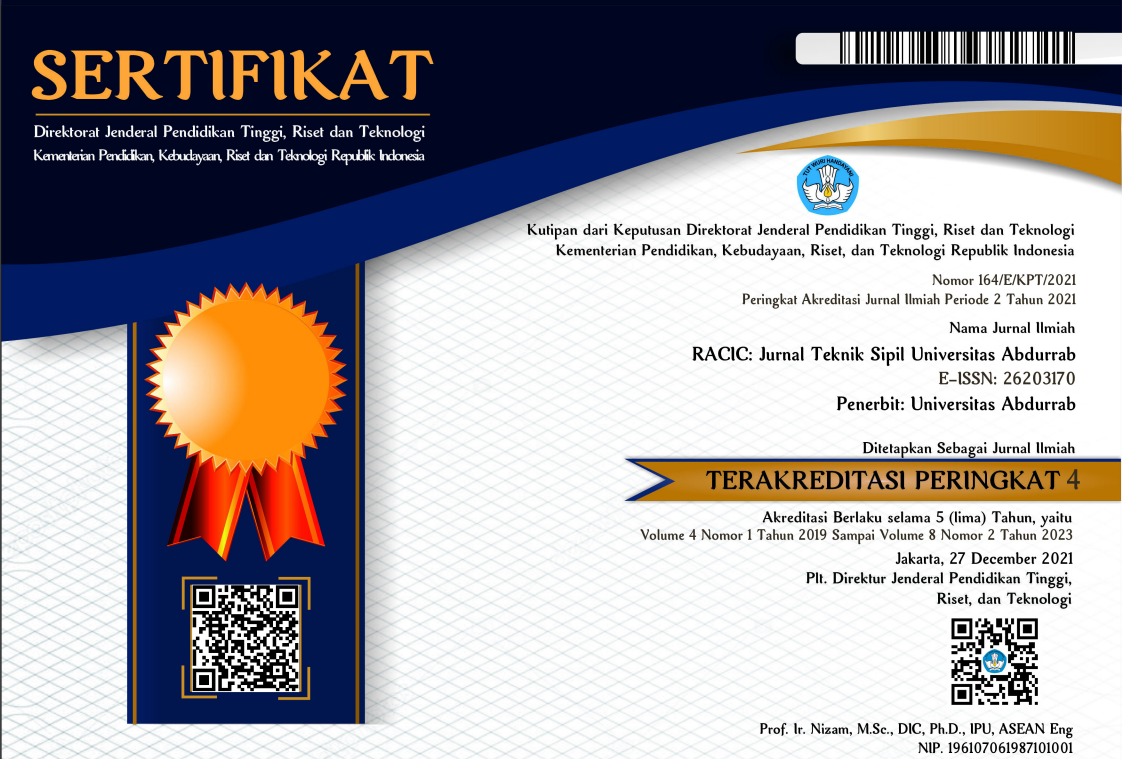IDENTIFIKASI RISIKO KETERLAMBATAN PEMBANGUNAN JALAN TOL DENGAN PENDEKATAN RII (RELATIVE IMPORTANCE INDEX) (Studi Kasus Pembangunan Jalan Tol Binjai – Pangkalan Brandan)
DOI:
https://doi.org/10.36341/racic.v9i1.4184Keywords:
Risk Identification, Delays, Relative Importance IndexAbstract
The Binjai – Pangkalan Brandan Toll Road is part of the Trans Sumatra Toll Road based on Presidential Regulation Number 117 of 2015. Based on information from providers and users, it has experienced delays in completion. The aim of this case study is to identify factors causing delays, analyze risks using a probabilistic. It is hoped that the case study in this research combines 2 analytical methods to provide new input for researchers. The RII (Relative Importance Index) method found 5 dominant factors that most influenced the delay in this project, namely land permits, inadequate land investigations before design work, inaccurate data surveys (pre-design), design changes, permits related to the government.
Downloads
References
Alotaibi, N. O. M. (2018). Managing critical factors causing delays in public construction projects in the Kingdom of Saudi Arabia. Curtin University.
Gündüz, M., Nielsen, Y., & Özdemir, M. (2013). Quantification of delay factors using the relative importance index method for construction projects in Turkey. Journal of Management in Engineering, 29(2), 133–139.
Patel, A. N., & Pitroda, J. (2017). Rankings of Factor Affecting Formwork Causing Delay in Construction Project By RII Method. Journal of Construction and Building Materials Engineering, 3(1).
Rahman, M. S., & Adnan, T. M. (2020). Risk management and risk management performance measurement in the construction projects of Finland. Journal of Project Management, 5, 167–178. https://doi.org/10.5267/j.jpm.2020.5.001
Rahmawati, dan Tenrisukki, N. (2020). Analisis Manajemen Risiko Pelaksanaan Pembangunan Jalan Tol (Studi Kasus : Proyek Pembangunan Jalan Tol Bekasi-Cawang-Kampung Melayu). Rekayasa Sipil, 14(1), 18–25. https://doi.org/10.21776/ub.rekayasasipil.2020.014.01.3
Rehacek, P., & Bazsova, B. (2018). Risk Management Methods in Projects. Journal of Eastern Europe Research in Business and Economics, 2018, 1–11. https://doi.org/10.5171/2018.790198
Ronal, dan T. (2020). HASIL ANALISIS KORELASI DAN INTERKORELASI RISIKO KETERLAMBATAN PROSES PELAKSANAAN KONSTRUKSI JALAN TOL Manlian Ronald A. Simanjuntak 1) , Anang Noer Tachlish 2). 369, 404–412.
Sandhyavitri, A., Aditya, A. dan, & Yusa, M. (2019). Mitigating Overloading Vehicle Effects in Relation to the Liddle Power Equations for Designing Road Pavement Lifespan. 186(APTE 2018), 36–42. https://doi.org/10.2991/apte-18.2019.8
Sandhyavitri, A., Talha, I., Fauzi, M., & Sutikno, S. (2017). Managing construction risks of the toll road project in Indonesia. International Journal on Advanced Science, Engineering and Information Technology, 7(5), 1934–1942. https://doi.org/10.18517/ijaseit.7.5.1349
Sandhyavitri, A., & Zulfiqar, M. (2014). Pada Tahap Konstruksi ( Studi Kasus Jalan Tol Pekanbaru-Dumai ). Jurnal Teknik Sipil, 10(iii), 1–15.
Sugiyono. (2007). Metode Penelitian Kuantitatif Kualitatif dan R & D : Alfabeta.
Uripto, U. T., & Sadalia, I. (2023). RISK MITIGATION IN THE LAUSIMEME DAM CONSTRUCTION PROJECT. 383–395.
Vasishta, N., Chandra, D. S., & Asadi, S. S. (2018). Analysis of risk assessment in construction of highway projects using relative importance index method. International Journal of Mechanical Engineering and Technology, 9(3), 1–6.
Downloads
Published
Issue
Section
License
1. Copyright of all journal manuscripts is held by the RACIC : Rab Construction Research
2. Formal legal provisions to access digital articles of electronic journal are subject to the provision of the Creative Commons Attribution-ShareAlike license (CC BY-NC-SA), which means that RACIC : Rab Construction Research is rightful to keep, transfer media/format, manage in the form of databases, maintain, and publish articles.
3. Published manuscripts both printed and electronic are open access for educational, research, and library purposes. Additionally, the editorial board is not responsible for any violations of copyright law.
licensed under a Creative Commons Attribution-ShareAlike 4.0 International License.





